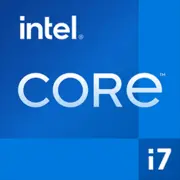Intel Core i7-12700

Intel Core i7-12700: Review and Guide for PC Build Selection in 2025
March 2025
Key Features: Alder Lake Architecture and Major Highlights
The Intel Core i7-12700 processor, released in late 2021, remains relevant in 2025 due to its hybrid Alder Lake architecture. It features 12 cores (8 Performance-cores and 4 Efficient-cores) and 20 threads, providing a balance between multitasking and energy efficiency.
- Intel 7 Process (10 nm Enhanced SuperFin): Reduces power consumption (TDP 65W) without sacrificing performance.
- Frequencies: P-cores operate at a base frequency of 2.1 GHz with turbo boost up to 4.8 GHz, E-cores up to 3.6 GHz.
- Cache: 25 MB of L3 cache speeds up data processing in games and professional applications.
- Integrated Graphics: UHD Graphics 770 (base frequency 300 MHz, maximum — 1.5 GHz) suitable for office tasks and light gaming.
- Performance: In Geekbench 6, the processor scores 2249 points in single-threaded and 10507 in multi-threaded tests, outperforming many models from the previous generation.
Key Features:
- Support for PCIe 5.0 and Thunderbolt 4 (via chipset).
- Intel Thread Director technologies for optimizing load on hybrid cores in Windows 11.
- Energy efficiency: even under load, consumption rarely exceeds 120W.
Compatible Motherboards: Sockets and Chipsets
The processor uses the LGA 1700 socket, which is supported by the 600 and 700 series chipsets:
- Z790/Z690: For enthusiasts. Support for overclocking, PCIe 5.0, DDR5. Examples: ASUS ROG Strix Z790-E (about $350).
- B660/H670: Optimal choice for most users. B660 (from $120) does not support overclocking but works with DDR4/DDR5.
- H610: Budget option (from $90) with limited PCIe 4.0 and DDR4 support.
Tip: If you do not plan to overclock, choose B660 with DDR4 — this will save you $100-150 on memory. For future upgrades (e.g., to Core i9-13900K), it’s better to go with Z790.
Memory Support: DDR4 vs DDR5
The Core i7-12700 works with both types of memory, but the choice depends on your budget and tasks:
- DDR4-3200: An affordable option (16 GB — $50). Suitable for gaming and everyday tasks.
- DDR5-4800+: More expensive (16 GB — $90), but provides a performance boost in rendering and "heavy" applications.
Practical Example: In tests of Cyberpunk 2077, the difference between DDR4 and DDR5 is 5-7 FPS, but in Blender, rendering speeds up by 12-15%.
Power Supply: Power Calculation
With a TDP of 65 W, the processor modestly impacts system power consumption. Recommendations:
- Without discrete graphics: A power supply of 300-400 W is sufficient (for example, be quiet! Pure Power 11 400W — $60).
- With a graphics card like RTX 4070: A power supply of 650-750 W (Corsair RM750e — $110).
- For high-end GPUs (RTX 4090): 850+ W and a PCIe 5.0 cable.
Important: Don’t skimp on the power supply — unstable power can damage components.
Pros and Cons of Core i7-12700
Pros:
- High multi-threaded performance for rendering and streaming.
- Low power consumption at idle.
- Integrated graphics — a lifesaver when a discrete graphics card is unavailable.
Cons:
- P-core temperatures can reach 85°C under load (requires a good cooler).
- Limited overclocking (only on Z-chipsets).
- DDR5 is more expensive but not always justified for gaming.
Use Cases
- Gaming: Paired with an RTX 4070 Ti, the processor delivers 144+ FPS at 1440p (e.g., Hogwarts Legacy — 132 FPS).
- Work Tasks: Video editing in Premiere Pro (4K timeline rendered in 18 minutes), programming in Docker.
- Multimedia: Streaming in OBS without lag thanks to 20 threads.
Comparison with Competitors
- AMD Ryzen 7 7700X: Priced at $320 (i7-12700 — $280). Better in single-threaded tasks (Geekbench 6 Single Core — 2450), but more expensive.
- Intel Core i5-13600K: At $260 offers 14 cores but is less stable in professional applications.
Conclusion: The i7-12700 excels in price/performance ratio for multi-threaded scenarios.
Build Tips
1. Cooling: Choose a tower cooler (DeepCool AK620 — $60) or AIO (NZXT Kraken X53 — $130).
2. Memory: For DDR5, get modules with heatsinks (G.Skill Trident Z5).
3. Motherboard: Check for PCIe 5.0 support if you plan to upgrade your graphics card.
4. BIOS Update: For 600-series chipsets, an update may be needed for compatibility with Windows 12.
Final Conclusion: Who Is the Core i7-12700 For?
This processor is ideal for:
- Gamers who want to play at 2K/4K without bottlenecks.
- Professionals: video editors, 3D designers, engineers.
- Enthusiasts building PCs with a 3-5 year future-proofing.
In 2025, the i7-12700 remains a cost-effective choice with a price of $250-300 and versatility. It lags behind the new Ryzen 8000 in single-threaded load but compensates with stability and low TDP. If you need a reliable "do-it-all" processor, this is your option.
Basic
CPU Specifications
Memory Specifications
GPU Specifications
Miscellaneous
Benchmarks
Compared to Other CPU
Related CPU Comparisons
Share in social media
Or Link To Us
<a href="https://cputronic.com/en/cpu/intel-core-i7-12700" target="_blank">Intel Core i7-12700</a>

